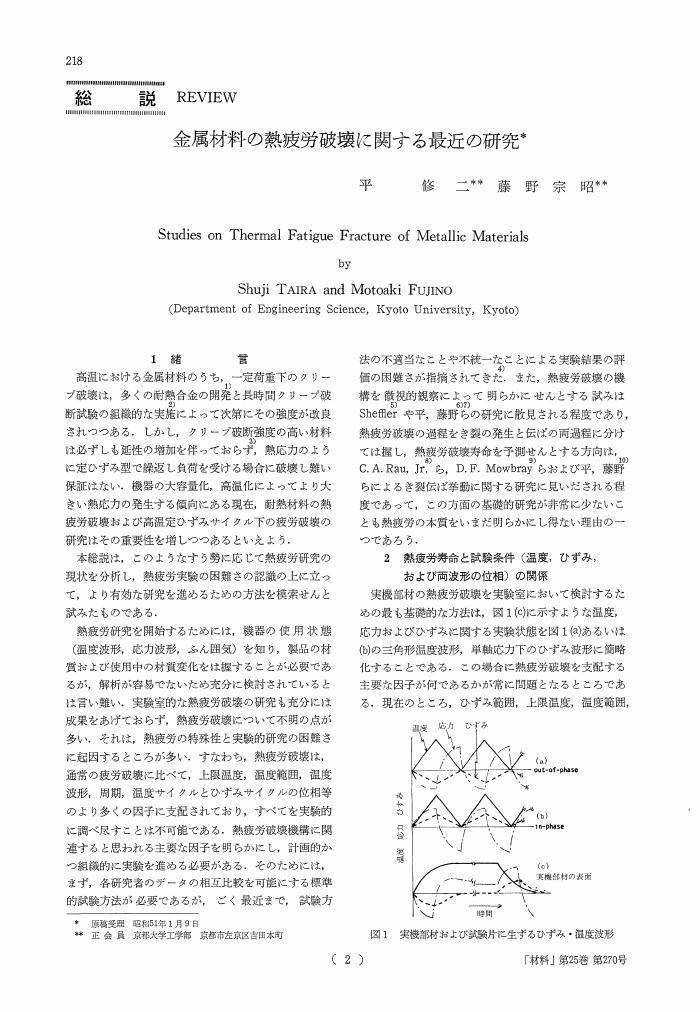4 0 0 0 OA 金属材料の熱疲労破壊に関する最近の研究
- 著者
- 平 修二 藤野 宗昭
- 出版者
- 公益社団法人 日本材料学会
- 雑誌
- 材料 (ISSN:05145163)
- 巻号頁・発行日
- vol.25, no.270, pp.218-229, 1976-03-15 (Released:2009-06-03)
- 参考文献数
- 55
- 被引用文献数
- 6 6
- 著者
- 千種 雄一 林 尚子 Salvador Isidro B. Destura Jusie Lydia J. Siega-Sur Meredith Del Pilar-Labarda 大平 修二 of Tropical Medicine and Parasitology Dokkyo Medical University Laboratory of Tropical Medicine and Parasitology Dokkyo Medical University Laboratory of Health Sciences University of the Philippines Manila School of Health Sciences University of the Philippines Manila School of Health Sciences University of the Philippines Manila School of International Environmental Health Dokkyo Medical University Laboratory 獨協医科大学 熱帯病寄生虫病室 獨協医科大学 熱帯病寄生虫病室 国立フィリピン大学健康科学部 国立フィリピン大学健康科学部 国立フィリピン大学健康科学部 獨協医科大学 国際環境衛生室. Laboratory of Tropical Medicine and Parasitology Dokkyo Medical University Laboratory of Tropical Medicine and Parasitology Dokkyo Medical University School of Health Sciences University of the Philippines Manila School of Health Sciences University of the Philippines Manila School of Health Sciences University of the Philippines Manila Laboratory of International Environmental Health Dokkyo Medical University
- 雑誌
- Dokkyo journal of medical sciences (ISSN:03855023)
- 巻号頁・発行日
- vol.40, no.3, pp.275-280, 2013-10-25
The establishment of the School of Health Sciences(SHS), University of the Philippines Manila (UPM) inLeyte in 1976 was based on the ideas of socially-concernedCollege of Medicine, UPM faculty who were alarmed by thebrain drain and the mal distribution of health manpower in the Philippines. SHS aims to produce a broad range of health manpower who serves the rural communities. It also designs and tests program models for health manpower developmentthat can be replicated in various parts of thePhilippines and in other countries as well.Its unique feature is the step-ladder curriculum---the only one of its kind in the Philippines---which is designed to meet the needs of the rural communities. Here, instead ofthe usual approach to health science education, the trainingof a broad range of health manpower from the barangay(village) health worker to the medical doctor is integratedin a single, sequential, and continuous curriculum. Each programlasts from one to more than 10 quarters( one quarter=11 weeks) and is followed by a service leave of an indefiniteperiod.The curriculum has been featured in many monographs,journals, magazine articles, and official reports of WHO forserving as a model for shifting health science educationfrom the hospital to the community.[Cited from:Improving the health of Filipinos throughexcellent and relevant programs, University of the PhilippinesManila]
1 0 0 0 OA フィリピンの日本住血吸虫症の現状とその他の感染症について
- 著者
- 四倉 玲 朝倉 真希 飯田 茉李 落合 祥子 鈴木 綾乃 高田 武蔵 松本 佳之 Terrad RayroseL Lipayon IgnacioL 大平 修二 千種 雄一 林 尚子 獨協医科大学医学部 獨協医科大学医学部 獨協医科大学医学部 獨協医科大学医学部 獨協医科大学医学部 獨協医科大学医学部 獨協医科大学医学部 フィリピン保健省東ミンドロ州住血吸虫症コントロールチーム フィリピン保健省住血吸虫症研究訓練センター 獨協医科大学国際環境衛生室 獨協医科大学熱帯病寄生虫病室 獨協医科大学熱帯病寄生虫病室
- 雑誌
- Dokkyo journal of medical sciences (ISSN:03855023)
- 巻号頁・発行日
- vol.38, no.2, pp.196, 2011-07-25
